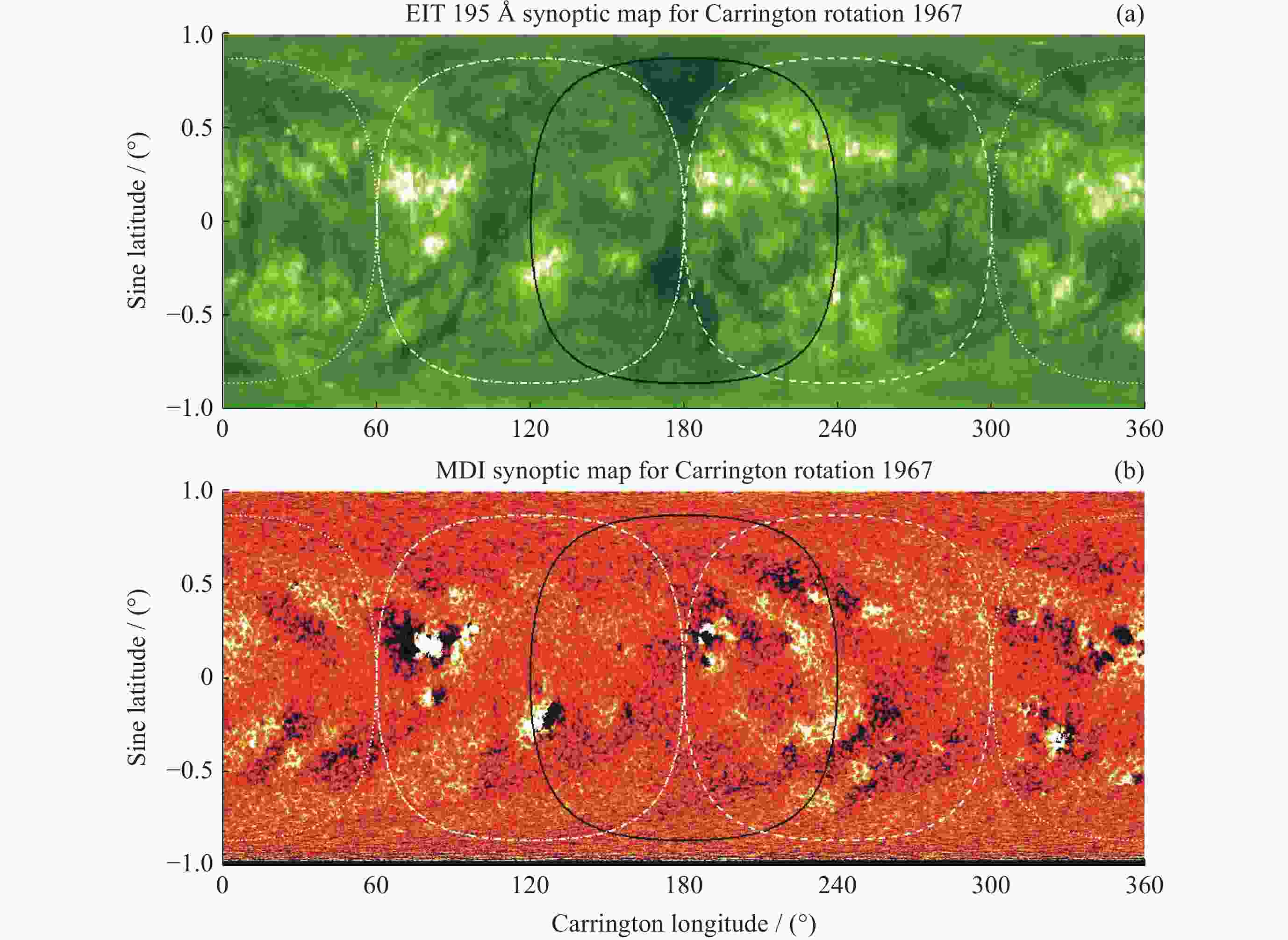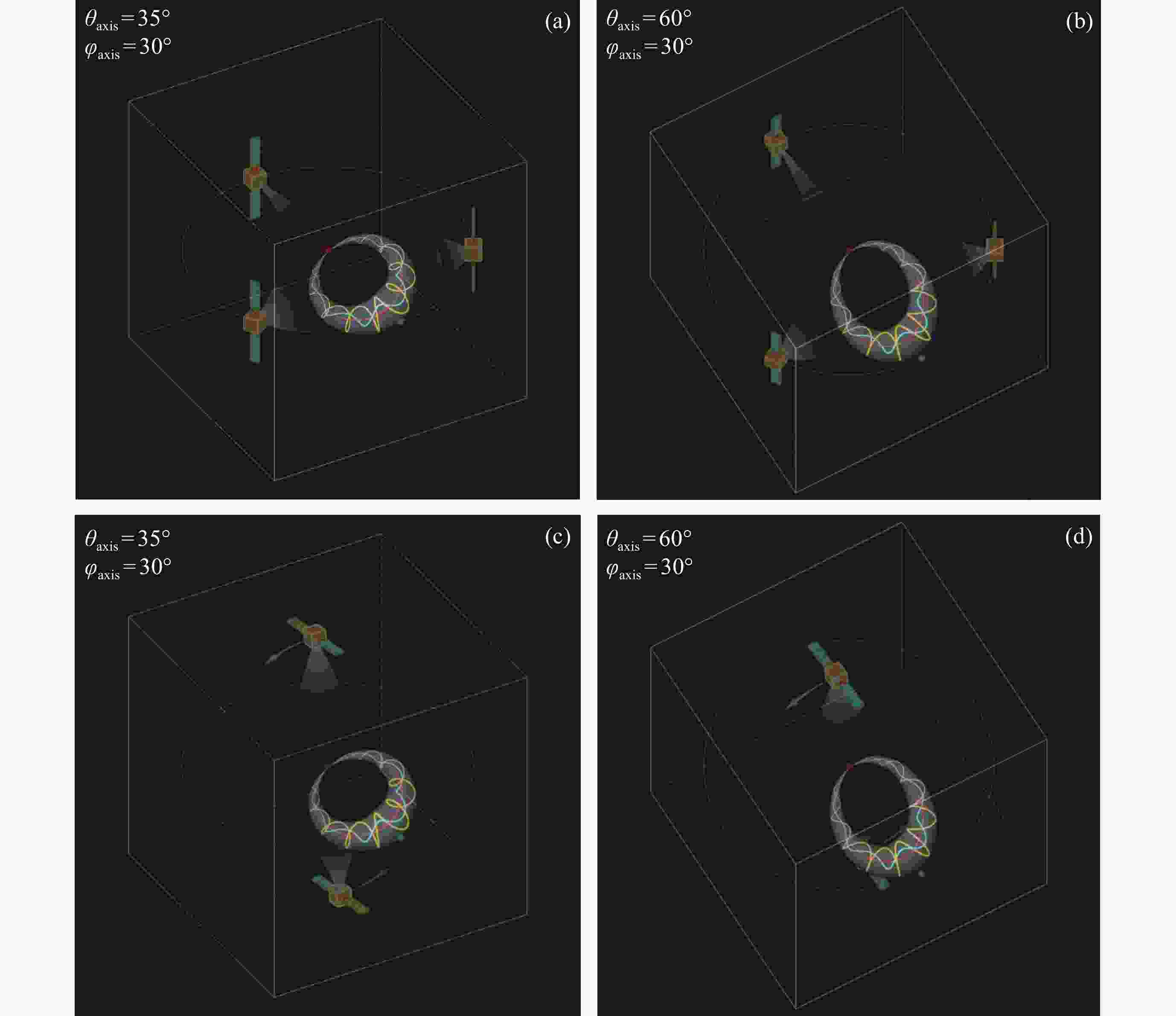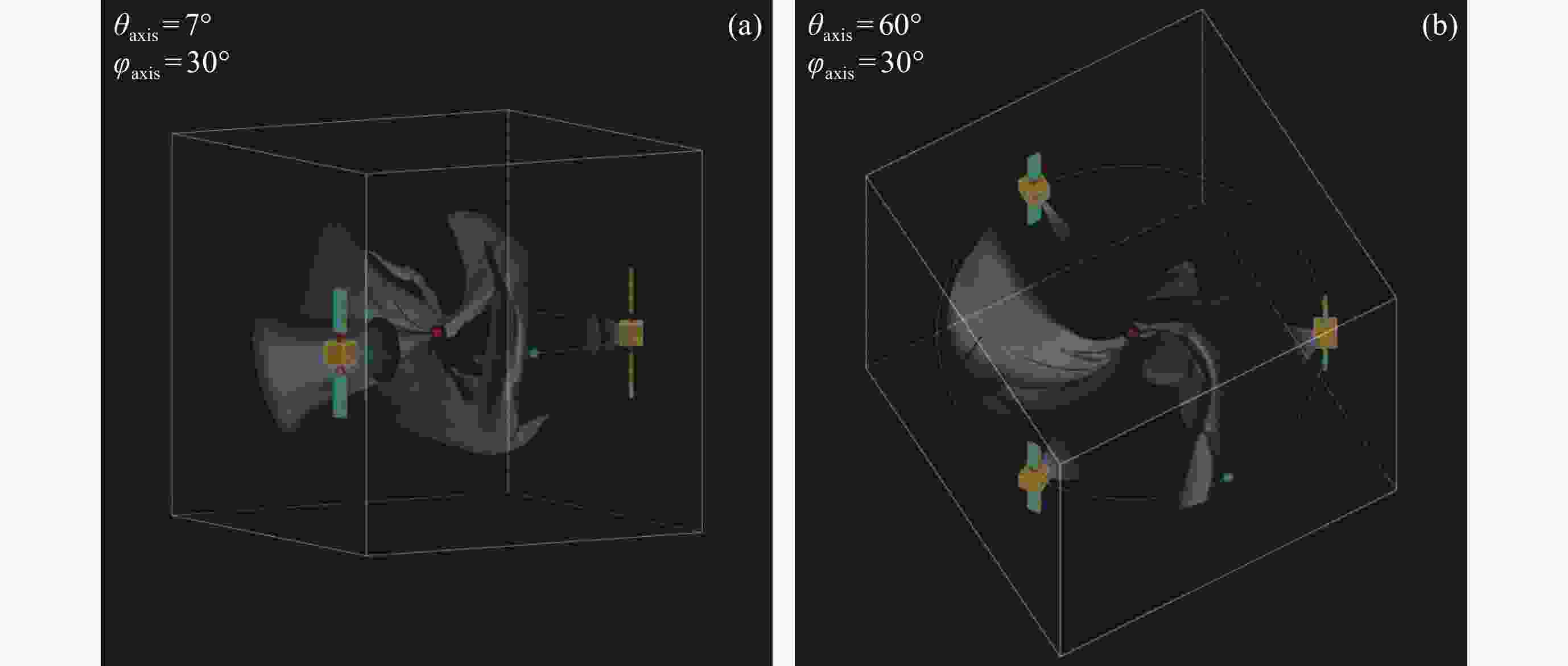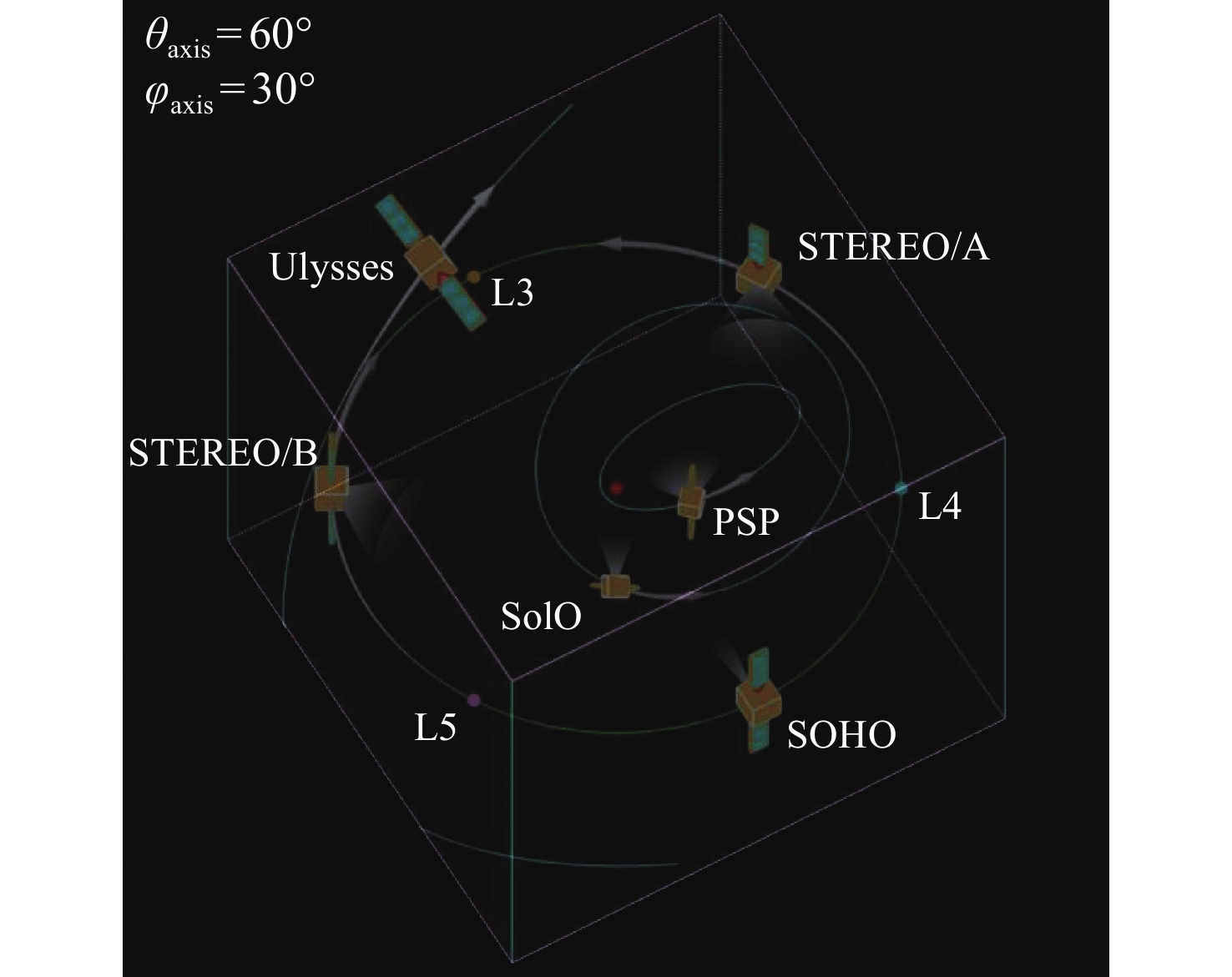Suggestions on Scientific Objectives of Deep-space Satellite Constellation to Explore the Sun and Inner-heliosphere from an Unprecedented Stereoscopic Panorama Viewpoint
-
摘要: 面向认知太阳风暴和保障航天安全的国家战略需求,中国近年来提出太阳与内日球立体探测卫星计划,拟适时部署环黄道面的拉格朗日点L3-L4-L5定点卫星星座和脱离黄道面的太阳极轨对偶卫星。通过该卫星计划的初步科学论证分析,建议将其科学目标凝练为太阳磁场、太阳风暴、太阳风,将其应用目标定位于日地空间天气预报,建议配置成像类、粒子类、波场类的综合科学载荷。此外,利用日地空间的三维磁流体数值模拟和计算机图形学的艺术可视化,形象地表达环黄道面卫星“对日凝视”和太阳极轨卫星“鸟瞰全景”的探测概念。中国太阳与内日球立体探测卫星计划将揭示太阳磁场的起源规律及其爆发机理、日地耦合系统的空间天气变化机理,并能够为日地空间天气三维数值建模提供观测数据驱动的初边值条件,必将极大推动空间天气的立体监测、前沿研究、精准预报的一体化进程。Abstract: To meet the national strategic demands in understanding solar storms and safeguarding deep-space exploration, several solar and interplanetary mission concepts have been recently proposed in China. These mission concepts include one Sun-orbiting Lagrangian L3-L4-L5 satellite constellation in the ecliptic and twin Sun-orbiting polar satellites out of the ecliptic, aiming at an unprecedented stereoscopic view of the Sun and the inner heliosphere. For the joint multi-constellation mission, its scientific objects can be defined as solar magnetic field, solar storm, and solar wind, with its application object identified as space weather prediction. Each satellite is suggested to carry a suit of scientific instruments to measure photon emissions, particle radiation, and electromagnetic waves. Using the three-dimensional numerical magnetohydrodynamic simulation of solar-terrestrial space and the aesthetic visualization of computer graphic design, the exploration scenario of the in-ecliptic Sun-staring satellites and the out-of-ecliptic bird-view satellites is vividly presented. The potential multi-constellation mission in China is expected to be able to uncover the mysterious origin and eruption of solar magnetic field, understand the space weather chain of Sun-Earth coupling system, and provide the initial and boundary conditions for three-dimensional data-driven space weather modelling. Therefore, if being carried out successfully, such a multi-constellation mission can be a historic landmark in improving the performance of space weather monitoring, research, and service in China.
-
图 1 历史上太阳与日球探测任务的若干卫星轨道(SOHO,Ulysses,STEREO A&B,PSP和SolO)及其对应的望远镜成像视场。SOHO位于日地引力平衡点L1,其余L3,L4,L5点标注在黄道面内的1 AU圆轨道上
Figure 1. Some Sun-orbiting satellite trajectories used in the historic solar and heliospheric exploration missions such as SOHO, Ulysses, STEREO A&B, PSP, and SolO. The fields of view of imaging cameras onboard these satellites are also illustrated. SOHO is located at Lagrangian point 1 (L1), with other L3, L4, and L5 points annotated at the Sun-centered circular orbit within the ecliptic plane at 1 AU
图 2 SOHO卫星在太阳卡灵顿周1967观测的全日面EIT极紫外概图(a)和MDI磁场概图(b)。以L1点和太阳连线为轴,60o张角的圆锥视场在日面的投影用黑实线表示。相应地,白点线、白虚线、白点划线分别表示L3,L4,L5点卫星成像视场在日面的投影
Figure 2. Full-disk synoptic maps of EUV emission (a) and magnetogram (b) during the solar Carrington rotation period 1967, observed by EIT and MDI instruments onboard SOHO respectively. Supposing a hypothetic camera with its Field of View (FOV) subtended by an angle of 60o around the Sun-L1 line, the FOV projection on the solar map is denoted as one black solid line. Accordingly, the projections of FOVs from cameras at points L3, L4, and L5 are respectively plotted as white-dotted, white-dashed, and white dashed-dotted lines
图 3 黄道面L3-L4-L5星座和太阳极轨对偶双星对行星际磁云(磁通量绳)的成像观测结果。(a)(c)和(b)(d)分别表示日球层中纬和高纬的显示视角。红点和绿点分别表示太阳与地球位置。绿线表示黄道面内的1 AU圆轨道,灰黑线表示太阳极轨
Figure 3. Stereoscopic imaging effect of interplanetary magnetic cloud (also called as magnetic flux rope) observation from a L3-L4-L5 satellite constellation in the ecliptic and twin satellites along a solar polar orbit. The viewing angles from intermediate and high latitudes of the heliosphere are respectively shown in panels (a)(c) and (b)(d). Here, the red dot, green dot, green line, and dark gray line are used to denote the Sun, Earth, ecliptic orbit, and polar orbit, respectively
图 4 黄道面L3-L4-L5星座对共转流相互作用区(CIR)的立体成像效果。(a)和(b)分别表示日球层赤道和高纬的显示视角。CIR三维密度分布数据来自观测数据驱动的内日球磁流体数值模拟
Figure 4. Stereoscopic imaging effect of Corotating Interaction Region (CIR) observation from a L3-L4-L5 satellite constellation in the ecliptic. The viewing angles from ecliptic and high latitudes of the heliosphere are respectively shown in panels (a) and (b). Here, the three-dimensional density distribution data of CIRs is generated from a data-driven numerical magnetohydrodynamic simulation of the inner heliosphere
表 1 历史上太阳与日球探测的里程碑式卫星计划
Table 1. A list of historic satellite missions characterized as milestones in exploring the Sun and heliosphere
卫星名称 国家及地区 运行周期 卫星轨道 科学目标 科学仪器载荷 部分重大科学成就 SOHO 欧洲、美国 1995年至今 日地连线L1点 研究太阳的结构、化学组成、太阳内部的动力学、太阳外部大气的结构 (密度、温度、速度等参数)及其动力学、太阳风及其与太阳大气的关系 日冕诊断光谱仪CDS,电荷、元素和同位素分析系统CELIAS,超热能量粒子综合分析仪COSTEP,极紫外望远镜EIT,广角分光日冕仪LASCO,麦克逊多普勒日震成像仪MDI,太阳紫外辐射光谱仪SUMER,太阳风各向异性探测仪SWAN,紫外日冕光谱仪UVCS,太阳全球低频测振仪GOLF,太阳辐射变化及引力振动探测仪VIRGO,荷电成分及同位素分析仪CELIAS,高能核及电子分析仪ERNE 被公认是现代太阳物理学的基石:首次发现太阳对流层和辐射层之间的旋切过渡层Tachocline,显著提升太阳活动周的磁场演化认知水平[6];首次可靠证实太阳内部结构的标准模型,首次发现太阳中微子亏损的根源在于基本粒子自身[7];首次发现太阳低层大气的磁毯网络组织以及中小尺度的磁场变化以及磁重联现象,显著提升日冕加热的科学认知水平[8];首次拍摄太阳耀斑和CME等太阳大气爆发活动在不同日心高度的完整动力学演化过程,首次连续追踪30 Rs以内的CME传播过程并拍摄上万个CME事件的白光精细影像,首次实现空间天气太阳源头的日常实时监测[9,10];首次发现太阳风高速流起源于色球网络组织的边缘[11],在4 Rs径向距离内完成主加速过程,具有高达几十的动理学温度各向异性值,并且重离子获得优势的加速和加热[12];首次发现太阳大气龙卷风、极紫外EIT波动、日震波、黑子下方的速度对流场、过渡区爆发式暂现事件等现象[13–17];史上最成功的彗星猎手,已发现4000余彗星,超过已知彗星数目的一半[18] STEREO 美国 2006年至今 黄道面内1 AU日心距的近圆轨道,每年偏离地球 22°的经向漂移(A和B双星分别前导和尾随地球) 研究CME触发机制及其在日球层中的传播特点;研究能量粒子在低日冕和行星际介质中的加速机制;研究太阳磁场的三维结构及其时间演化,研究局地太阳风的等离子体和磁场结构 日地关联日冕和日球层探测仪SECCHI,粒子和日冕物质抛射原位测量仪IMPACT,等离子体和超热离子成分PLASTIC,射电暴探测仪WAVES 首次实现偏离日地连线的对日成像观测,首次实现针对太阳与日球的双视角联合成像,对冕环和CME等结构开展三维重构[19];首次捕捉到地球轨道附近行星际CME的白光微弱辐射影像,首次连续追踪CME沿日地连线的完整传播过程[20] Ulysses 美国、欧洲 1990—2009年 木星借力的绕日大椭圆轨道,相对于黄道面的轨道倾角达80° 研究行星际磁场和太阳风的全球三维特征,研究太阳风的起源、太阳耀斑中的能量粒子加速,研究银河宇宙线以及星际尘埃性质与日球层纬度的关系 磁强计VHM/FGM,太阳风等离子体测量仪SWOOPS,太阳风离子成分谱仪SWICS,射电波和等离子体波探测仪URAP,能量粒子分析仪 EPAC, 星际中性气体探测仪GAS, 日球层低能频谱、成分和各向异性探测仪HISCALE,宇宙线和太阳粒子探测仪COSPIN,伽马射线暴探测仪GRB,宇宙尘埃探测仪DUST 首次飞越太阳南北两极,首次发现太阳两极的磁极强度和温度有显著的差异[21];首次绘制太阳活动周尺度上太阳风高速流及低速流的速度、温度、磁场等参数的纬向分布,首次发现行星际磁场极性在每11年尺度上发生倒转[22];发现从深空进入太阳系的尘埃比预期值高30倍,发现太阳极区磁场强度比预期值更弱,发现1990—2009年探测任务期间的太阳风持续减弱[23] SDO 美国 2010年至今 西经102°附近,倾斜28°的地球同步轨道,高度35800 km 研究太阳磁场的发电机起源及其结构演化,研究太阳磁场储能的转移和释放方式,研究太阳磁活动导致日球层的太阳风、能量粒子、太阳辐射等变化响应,以提升空间天气的预报能力 日震与磁成像仪HMI,
极紫外线变化实验仪EVE,
大气成像组件AIA首次开启太阳全日面、多波段、高时空分辨率成像观测新纪元,首次高清记录太阳黑子、CME、太阳耀斑、太阳龙卷风、太阳极紫外EIT波动、日冕暗化、极区冕洞、冕环、冕羽等多尺度现象的完整丰富细节[24];首次开启太阳观测的大数据时代,首次实现每日1.5 TB量级的观测数据量的星地传输,开辟太阳物理机器学习和人工智能等新学科方向[25];首次发现太阳内部多层子午环流、太阳耀斑的极紫外延迟相、太阳自发磁场重联[26,27] PSP 美国 2018年至今 黄道面内绕日的大椭圆轨道,实现24次的近日点飞行,利用7次金星借力而逐步将近日点缩短至 9.86 Rs 追踪加热日冕与加速太阳风的能量流动,确定太阳风源头等离子体与磁场的结构,探索能量粒子的加速和传输机制 电磁场探测仪FIELDS,宽视场成像仪WISPR,太阳风电子、α粒子和质子探测器SWEAP,太阳综合科学仪器IS☉IS 首次深入太阳大气层进行就位测量的卫星:首次发现在30 Rs处远高于Weber-Davis太阳风角动量模型预测值的切向太阳风速度[28];发现来自赤道冕洞的太阳风低速流、太阳风中磁场的弯折、阿尔芬速度尖峰结构、太阳附近的能量粒子辐射环境等现象[29,30];证实近日无尘区的存在[31] Solar Orbiter 欧洲、美国 2020年至今 黄道面内绕日的大椭圆轨道,利用多次金星借力,实现相对于黄道面的轨道倾角大于33°,且最终近日点缩短至0.28 AU 研究太阳风的驱动源与日冕磁场的起源、太阳瞬变活动驱动的日球层变化、太阳爆发产生的日球层能量粒子辐射、太阳磁场发电机的运作及其对太阳与日球层两者关联的驱动方式 太阳风分析仪SWA,磁强计MAG,射电暴和等离子体波探测仪RPW,能量粒子探测器EPD,全日面极紫外成像仪EUI,日冕仪METIS, 偏振和日震成像仪PHI,日球仪SoloHI,极紫外光谱成像仪SPICE,X射线谱仪STIX 2021年11月开启常规科学观测:首次捕捉到有史以来在单张图像中观测到的最大日珥喷发,延伸至行星际空间达到数百万英里尺度[32];高清拍摄宁静太阳的众多小尺度活动现象,例如小而明亮的“篝火”微耀斑[33] 表 2 太阳与日球物理领域悬而未决的重大科学问题及其对空间天气预报能力的严重制约、当前观测手段的欠缺以及未来的应对措施
Table 2. Major outstanding science problems in the field of solar and heliospheric physics, humankind's insufficient understanding of these problems resulting in serious limitation in space weather prediction capability, and current lack of observation methods and future remedies in monitoring the Sun
悬而未决的重大科学问题 科学认知不足的具体证据 空间天气预报能力的不足 当前对日观测手段的欠缺 亟待弥补的深空卫星观测能力 太阳活动区的三维复杂磁拓扑演化及其爆发机制 日冕磁绳的形成和爆发过程;多个活动区之间的磁拓扑连接和交感爆发途径 对于复杂活动区的耀斑爆发,基本无预报能力,无法预报其发生时间和爆发强度 太阳磁场测量存在横场方向的180°不确定性;缺乏单个太阳活动区从磁浮现至消亡的连续正视观测 单个太阳活动区的多视角立体监测;经度方向的多视角拼接形成全周向视场,持续接力而连续覆盖随太阳自转的太阳活动区目标。期望3颗黄道星,经向间隔120°,每星都可提供至少arcsec及10 min量级分辨率的全日面太阳磁图 背景太阳风及其携带行星际磁场的三维大尺度空间结构及其时变演化规律 日球层电流片、日球层等离子体片、共转流相互作用区的三维立体结构;行星际磁力线的三维位形及其日面开放场起源 仅能大致预报日地L1点处的背景太阳风和行星际磁场极性的日平均变化 仅有太阳自转卡灵顿周尺度的全日面综合磁场概图,存在时空维度的插值光滑效应,并且缺失太阳两极的磁场观测;仅有地球固定视角和STEREO漂移视角的全日面极紫外观测和白光日冕观测;缺少太阳极轨视角的遥感成像,无法直接解析经度方向的结构信息 太阳南北两极的光球磁场测量和开放磁通监测;太阳光球磁场测量的全球面覆盖,实时追踪光球磁场中性线的动态变化;低纬度全周向甚至全球面的全日面极紫外和白光日冕辐射监测。期望3颗黄道星和2颗太阳极轨星,每星都可提供至少 arcsec 及10 min量级分辨率的全日面太阳磁图、至少arcsec及 min 量级分辨率的全日面多波段极紫外辐射图、至少10 arcsec及10 min量级分辨率的白光日冕图、磁强计、太阳风等离子体探测仪 日冕物质抛射CME的三维传播规律及其磁流特征 背景太阳风结构对CME传播的调控作用;CME携带动量、能量、总磁通、南向磁通的变化过程 对于CME传播至地球的到达时间,统计平均的预报误差约为12 h;无法预报CME南向磁通;无法判断CME可能发生加减速和偏转的运动学传播轨迹 仅有地球固定视角和STEREO漂移视角的全日面极紫外观测、白光日冕观测、白光日球观测;缺少太阳极轨视角的遥感成像,无法直接解析经度方向的结构信息 环黄道面的多视角联测,监测全日面极紫外辐射、白光日冕和日球辐射。期望3颗黄道星和1颗太阳极轨星,每星都可提供至少 arcsec 及 min 量级分辨率的全日面多波段极紫外辐射图、至少10 arcsec及10 min量级分辨率的白光日冕图、至少 arcmin 及 30 min量级分辨率的白光日球图、磁强计、太阳风等离子体探测仪 太阳高能粒子SEP在低日冕的加速机理和行星际三维传播规律 SEP在低日冕的加速区域和加速效率;SEP在行星际传播时横越磁力线扩散的蓄水池效应 仅局限于黄道面内的二维SEP传播预报,且以经验和统计分析为主 缺乏L5点的粒子探测,不能提前预警对地CME产生的SEP事件 L5点的能量粒子监测,低日冕的激波监测。期望1颗黄道星,位于L5点,提供至少10 arcsec及10 min量级分辨率的白光日冕图、多能段的高能粒子探测器 太阳磁活动周的演化规律 太阳极区磁场的极性反转;极区磁场的双极磁浮现和可能的局地发电机过程;较差自转和子午环流对光球磁通的大尺度输运效应 仍处于尝试探索阶段,预报方差过大,甚至不同方法的预报结果互相矛盾 仅有地球视角的太阳磁场测量,太阳背面和太阳两极是探测盲区 太阳全球面(特别是太阳极区)的磁场和速度场成像。期望3颗黄道星和2颗太阳极轨星,每星都可提供至少arcsec及10 min量级分辨率的全日面太阳磁图(其中速度场的时间分辨率为 min 量级) 表 3 太阳与内日球立体探测卫星计划的科学目标及载荷配置的对应关系
Table 3. Scientific objectives and payload configuration of satellite constellation mission to explore the Sun and the inner heliosphere in three dimensions
科学目标 探测区域 科学载荷 发现太阳全球整体磁场活动规律、太阳活动区磁拓扑结构及其爆发机制、太阳磁活动周起源以及这三者之间跨时空尺度的物理关联 太阳内部结构和太阳低层大气(光球、色球、过渡区、内冕) 遥感成像(磁像仪、极紫外多波段成像仪、日冕仪) 揭示太阳风暴的三维磁流结构及其在日地空间的传播和演化过程 太阳中高日冕、行星际空间 遥感成像(日冕仪、日球仪、射电暴频谱仪);就位测量(太阳风等离子体探测仪、磁强计、高能离子探测器、高能重离子成分探测仪) 解密太阳风的日面起源、内冕加速、行星际三维大尺度空间结构 完整太阳大气、行星际空间 遥感成像(磁像仪、极紫外多波段成像仪、日冕仪、日球仪);就位测量(太阳风等离子体探测仪、磁强计) 表 4 太阳与内日球立体探测卫星计划的科学载荷关键技术参数
Table 4. Key technological parameters of scientific payloads accommodated by a satellite constellation mission to explore the Sun and the inner heliosphere in three dimensions
科学载荷名称 关键技术参数 谱像遥感
探测载荷全日面磁场和速度场成像仪 视场:33′
分辨率:2′ ′ pixel–1
工作波长:5324 Å
磁场精度:纵场5 Gauss,横场150 Gauss,时间分辨率10 min
速度精度:灵敏度20 m·s–1,时间分辨率1 min全日面极紫外成像仪 视场:45′
分辨率:1.5′ ′ pixel–1
时间分辨率:3 min
工作波段:1216 Å,131 Å白光日冕仪 视场:1.5~30 Rs
分辨率:15′ ′ pixel–1
时间分辨率:10 min
带宽:650~750 nm
杂散光抑制能力:10–12 ${B_ \odot } $白光日球仪 视场:30~215 Rs
分辨率:1.2′ pixel–1
时间分辨率:30 min
带宽:630~730 nm
杂散光抑制能力:10–14 ${B_ \odot } $粒子就位
探测载荷太阳风等离子体探测仪 视场:6.7° × 180°扇面
极角分辨:6°
方位角分辨:15°
时间分辨率:1 min
能段:0.05~20 keV磁强计 量程范围:± 256 nT
噪声水平:< 0.01 nT·Hz –1/2 @ 1 Hz
时间分辨率:0.1 s高能粒子探测仪 视场:40°
质子能段:4~400 MeV
电子能段:0.1~2 MeV
时间分辨率:10 s高能重离子成分探测仪 视场:40°
元素范围:2 < Z < 26
能量:8~100 MeV/n
时间分辨率: 10 s太阳射电暴探测仪 频率:10 kHz~16 MHz
灵敏度:5 nV·Hz–1/2
动态范围:120 dB
时间分辨率:1 s表 5 太阳与内日球立体探测的卫星星座构成及其监测功能实现
Table 5. Constituent satellites and their corresponding observation capability of satellite constellation mission to explore the Sun and the inner heliosphere in three dimensions
卫星组网 卫星组成 监测功能 最简配置 L5点卫星 日地连线 简化配置 L4,L5点卫星 太阳与内日球的中低纬区域(除背面的经度范围) 完整配置 L3,L4,L5点卫星 太阳与内日球的中低纬区域(全周向的经度范围) 拓展配置 L3,L4,L5点卫星;
太阳极轨的单星或双星太阳与内日球的全三维空间(无盲区) -
[1] BALOGH A, LANZERO L, SUESS S T. The Heliosphere Through the Solar Activity Cycle[M]. Berlin: Springer, 2010 [2] Committee on a Decadal Strategy for Solar and Space Physics, Space Studies Board, Aeronautics and Space Engineering Board, et al. Solar and Space Physics: A Science for a Technological Society[M]. Washington: The National Academies Press, 2013 [3] 魏奉思. 空间天气学[J]. 地球物理学进展, 1999, 14(S1): 1-7 doi: 10.3969/j.issn.1004-2903.1999.z1.001WEI Fengsi. Space weather[J]. Progress in Geophysics, 1999, 14(S1): 1-7 doi: 10.3969/j.issn.1004-2903.1999.z1.001 [4] 汪景琇, 季海生. 空间天气驱动源——太阳风暴研究[J]. 中国科学:地球科学, 2013, 56(7): 1091-1117 doi: 10.1007/s11430-013-4648-8WANG Jingxiu, JI Haisheng. Recent advances in solar storm studies in China[J]. Science China Earth Sciences, 2013, 56(7): 1091-1117 doi: 10.1007/s11430-013-4648-8 [5] National Science and Technology Council. National Space Weather Strategy: Space Weather Operations, Research, and Mitigation (SWORM) Task Force[M]. Washington: Executive Office of the President of the United States, 2015 [6] THOMPSON M J, TOOMRE J, ANDERSON E R, et al. Differential rotation and dynamics of the solar interior[J]. Science, 1996, 272(5266): 1300-1305 doi: 10.1126/science.272.5266.1300 [7] TURCK-CHIÈZE S, COUVIDAT S. Solar neutrinos, helioseismology and the solar internal dynamics[J]. Reports on Progress in Physics, 2011, 74(8): 086901 doi: 10.1088/0034-4885/74/8/086901 [8] SCHRIJVER C J, TITLE A M, VAN BALLEGOOIJEN A A, et al. Sustaining the quiet photospheric network: the balance of flux emergence, fragmentation, merging, and cancellation[J]. The Astrophysical Journal, 1997, 487(1): 424-436 doi: 10.1086/304581 [9] YASHIRO S, GOPALSWAMY N, MICHALEK G, et al. A catalog of white light coronal mass ejections observed by the SOHO spacecraft[J]. Journal of Geophysical Research: Space Physics, 2004, 109(A7): A07105 [10] TSURUTANI B T, JUDGE D L, GUARNIERI F L, et al. The October 28, 2003 extreme EUV solar flare and resultant extreme ionospheric effects: comparison to other Halloween events and the bastille day event[J]. Geophysical Research Letters, 2005, 32(3): L03S09 [11] TU C Y, ZHOU C, MARSCH E, et al. Solar wind origin in coronal funnels[J]. Science, 2005, 308(5721): 519-523 doi: 10.1126/science.1109447 [12] KOHL J L, NOCI G, ANTONUCCI E, et al. UVCS/SOHO empirical determinations of anisotropic velocity distributions in the solar corona[J]. The Astrophysical Journal, 1998, 501(1): L127-L131 doi: 10.1086/311434 [13] THOMPSON B J, PLUNKETT S P, GURMAN J B, et al. SOHO/EIT observations of an Earth-directed coronal mass ejection on May 12, 1997[J]. Geophysical Research Letters, 1998, 25(14): 2465-2468 doi: 10.1029/98GL50429 [14] KOSOVICHEV A G, ZHARKOVA V V. X-ray flare sparks quake inside sun[J]. Nature, 1998, 393(6683): 317-318 doi: 10.1038/30629 [15] PIKE C D, MASON H E. Rotating transition region features observed with the SOHO coronal diagnostic spectrometer[J]. Solar Physics, 1998, 182(2): 333-348 doi: 10.1023/A:1005065704108 [16] ZHAO J W, KOSOVICHEV A G, DUVALL T L JR. Investigation of mass flows beneath a sunspot by time-distance helioseismology[J]. The Astrophysical Journal, 2001, 557(1): 384-388 doi: 10.1086/321491 [17] TERIACA L, BANERJEE D, FALCHI A, et al. Transition region small-scale dynamics as seen by SUMER on SOHO[J]. Astronomy & Astrophysics, 2004, 427(3): 1065-1074 [18] BIESECKER D A, LAMY P, ST CYR O C, et al. Sungrazing comets discovered with the SOHO/LASCO coronagraphs 1996-1998[J]. Icarus, 2002, 157(2): 323-348 doi: 10.1006/icar.2002.6827 [19] HARRISON R A, DAVIS C J, EYLES C J, et al. First imaging of coronal mass ejections in the heliosphere viewed from outside the Sun - Earth line[J]. Solar Physics, 2008, 247(1): 171-193 doi: 10.1007/s11207-007-9083-6 [20] DEFOREST C E, HOWARD T A, TAPPIN S J. Observations of detailed structure in the solar wind at 1 AU with STEREO/HI-2[J]. The Astrophysical Journal, 2011, 738(1): 103 doi: 10.1088/0004-637X/738/1/103 [21] MCCOMAS D J, BARRACLOUGH B L, FUNSTEN H O, et al. Solar wind observations over Ulysses’ first full polar orbit[J]. Journal of Geophysical Research: Space Physics, 2000, 105(A5): 10419-10433 doi: 10.1029/1999JA000383 [22] MCCOMAS D J, ELLIOTT H A, SCHWADRON N A, et al. The three-dimensional solar wind around solar maximum[J]. Geophysical Research Letters, 2003, 30(10): 1517 [23] MCCOMAS D J, EBERT R W, ELLIOTT H A, et al. Weaker solar wind from the polar coronal holes and the whole sun[J]. Geophysical Research Letters, 2008, 35(18): L18103 doi: 10.1029/2008GL034896 [24] LIU W, OFMAN L. Advances in observing various coronal EUV waves in the SDO era and their seismological applications (invited review)[J]. Solar Physics 2014, 289(9): 3233-3277 [25] BOBRA M G, COUVIDAT S. Solar flare prediction using SDO/HMI vector magnetic field data with a machine-learning algorithm[J]. The Astrophysical Journal, 2015, 798(2): 135 doi: 10.1088/0004-637X/798/2/135 [26] ZHAO J W, BOGART R S, KOSOVICHEV A G, et al. Detection of equatorward meridional flow and evidence of double-cell meridional circulation inside the Sun[J]. The Astrophysical Journal, 2013, 774(2): L29 doi: 10.1088/2041-8205/774/2/L29 [27] WOODS T N, HOCK R, EPARVIER F, et al. New solar extreme-ultraviolet irradiance observations during flares[J]. The Astrophysical Journal, 2011, 739(2): 59 doi: 10.1088/0004-637X/739/2/59 [28] KASPER J C, BALE S D, BELCHER J W, et al. Alfvénic velocity spikes and rotational flows in the near-sun solar wind[J]. Nature, 2019, 576(7786): 228-231 doi: 10.1038/s41586-019-1813-z [29] BALE S D, BADMAN S T, BONNELL J W, et al. Highly structured slow solar wind emerging from an equatorial coronal hole[J]. Nature, 2019, 576(7786): 237-242 doi: 10.1038/s41586-019-1818-7 [30] MCCOMAS D J, CHRISTIAN E R, COHEN C M S, et al. Probing the energetic particle environment near the Sun[J]. Nature, 2019, 576(7786): 223-227 doi: 10.1038/s41586-019-1811-1 [31] HOWARD R A, VOURLIDAS A, BOTHMER V, et al. Near-Sun observations of an F-corona decrease and K-corona fine structure[J]. Nature, 2019, 576(7786): 232-236 doi: 10.1038/s41586-019-1807-x [32] MIERLA M, ZHUKOV A N, BERGHMANS D, et al. Prominence eruption observed in He II 304 Å up to >6 R⊙ by EUI/FSI aboard solar orbiter[J]. Astronomy & Astrophysics, 2022, 662: L5 [33] BERGHMANS D, AUCHÈRE F, LONG D M, et al. Extreme-UV quiet sun brightenings observed by the solar orbiter/EUI[J]. Astronomy & Astrophysics, 2021, 656: L4 [34] WENZEL K P, MARSDEN R G, PAGE D E, et al. The Ulysses mission[J]. Astronomy and Astrophysics Supplement, 1992, 92(2/JAN): 207 [35] FOX N J, VELLI M C, BALE S D, et al. The solar probe plus mission: humanity’s first visit to our star[J]. Space Science Reviews, 2016, 204(1/2/3/4): 7-48 [36] MÜLLER D, MARSDEN R G, ST CYR O C, et al. Solar orbiter: exploring the sun–heliosphere connection[J]. Solar Physics, 2013, 285(1/2): 25-70 [37] XIONG M, DAVIES J A, BISI M M, et al. Effects of Thomson-scattering geometry on white-light imaging of an interplanetary shock: synthetic observations from forward magnetohydrodynamic modelling[J]. Solar Physics, 2013, 285(1/2): 369-389 [38] 周茹芸, 汪毓明, 宿英娜, 等. 利用双视角改正太阳矢量磁场观测中的180°不确定性[J]. 天文学报, 2021, 62(4): 41ZHOU Ruyun, WANG Yuming, SU Yingna, et al. Using observations of solar vector magnetic field from dual view points to remove the 180° ambiguity[J]. Acta Astronomica Sinica, 2021, 62(4): 41 [39] ZHOU G P, WANG J X, WANG Y M, et al. Quasi-simultaneous flux emergence in the events of October-November 2003[J]. Solar Physics, 2007, 244(1/2): 13-24 [40] CAMERON R, SCHÜSSLER M. The crucial role of surface magnetic fields for the solar dynamo[J]. Science, 2015, 347(6228): 1333-1335 doi: 10.1126/science.1261470 [41] GIZON L, CAMERON R H, BEKKI Y, et al. Solar inertial modes: observations, identification, and diagnostic promise[J]. Astronomy & Astrophysics, 2021, 652: L6 [42] GIZON L, CAMERON R H, POURABDIAN M, et al. Meridional flow in the Sun’s convection zone is a single cell in each hemisphere[J]. Science, 2020, 368(6498): 1469-1472 doi: 10.1126/science.aaz7119 [43] PRIEST E R, LONGCOPE D W. The creation of twist by reconnection of flux tubes[J]. Solar Physics, 2020, 295(3): 48 doi: 10.1007/s11207-020-01608-0 [44] TÖRÖK T, KLIEM B. Confined and ejective eruptions of kink-unstable flux ropes[J]. The Astrophysical Journal, 2005, 630(1): L97-L100 doi: 10.1086/462412 [45] BURLAGA L, SITTLER E, MARIANI F, SCHWENN R. Magnetic loop behind an interplanetary shock: Voyager, Helios, and IMP 8 observations[J]. Journal of Geophysical Research: Space Physics, 1981, 86(A8): 6673-6684 doi: 10.1029/JA086iA08p06673 [46] WANG Y M, ZHUANG B, HU Q, et al. On the twists of interplanetary magnetic flux ropes observed at 1 AU[J]. Journal of Geophysical Research: Space Physics, 2016, 121(10): 9316-9339 doi: 10.1002/2016JA023075 [47] LIU Y, DAVIES J A, LUHMANN J G, et al. Geometric triangulation of imaging observations to track coronal mass ejections continuously out to 1 AU[J]. The Astrophysical Journal, 2010, 710(1): L82-L87 doi: 10.1088/2041-8205/710/1/L82 [48] LUGAZ N, HERNANDEZ-CHARPAK J N, ROUSSEV I I, et al. Determining the azimuthal properties of coronal mass ejections from multi-spacecraft remote-sensing observations with STEREO SECCHI[J]. The Astrophysical Journal, 2010, 715(1): 493-499 doi: 10.1088/0004-637X/715/1/493 [49] LYU S Y, WANG Y M, LI X L, et al. Three-dimensional reconstruction of coronal mass ejections by the correlation-aided reconstruction technique through different stereoscopic angles of the solar terrestrial relations observatory twin spacecraft[J]. The Astrophysical Journal, 2021, 909(2): 182 doi: 10.3847/1538-4357/abd9c9 [50] XIONG M, DAVIES J A, HARRISON R A, et al. Prospective out-of-ecliptic white-light imaging of coronal mass ejections traveling through the corona and heliosphere[J]. The Astrophysical Journal, 2018, 852(2): 111 doi: 10.3847/1538-4357/aaa028 [51] XIONG M, DAVIES J A, FENG X S, et al. Prospective white-light imaging and in situ measurements of quiescent large-scale solar-wind streams from the Parker Solar Probe and Solar Orbiter[J]. The Astrophysical Journal, 2018, 868(2): 137 doi: 10.3847/1538-4357/aae978 [52] BEMPORAD A. Possible advantages of a twin spacecraft heliospheric mission at the Sun-Earth Lagrangian points L4 and L5[J]. Frontiers in Astronomy and Space Sciences, 2021, 8: 627576 doi: 10.3389/fspas.2021.627576 [53] WANG Y M, YE P Z, WANG S, et al. A statistical study on the geoeffectiveness of Earth-directed coronal mass ejections from March 1997 to December 2000[J]. Journal of Geophysical Research: Space Physics, 2002, 107(A11): 1340 doi: 10.1029/2002JA009244 [54] ZHANG J, DERE K P, HOWARD R A, et al. Identification of solar sources of major geomagnetic storms between 1996 and 2000[J]. The Astrophysical Journal, 2003, 582(1): 520-533 doi: 10.1086/344611 [55] LIU Y D, HU H D, WANG C, et al. On sun-to-Earth propagation of coronal mass ejections: II. Slow events and comparison with others[J]. The Astrophysical Journal, 2016, 222(2): 23 doi: 10.3847/0067-0049/222/2/23 [56] WEI F S, DRYER M. Propagation of solar flare-associated interplanetary shock waves in the heliospheric meridional plane[J]. Solar Physics, 1991, 132(2): 373-394 doi: 10.1007/BF00152294 [57] BURLAGA L F, BEHANNON K W, KLEIN L W. Compound streams, magnetic clouds, and major geomagnetic storms[J]. Journal of Geophysical Research, 1987, 92(A6): 5725 doi: 10.1029/JA092iA06p05725 [58] WANG Y M, YE P Z, WANG S. Multiple magnetic clouds: several examples during March-April 2001[J]. Journal of Geophysical Research: Space Physics, 2003, 108(A10): 1370 doi: 10.1029/2003JA009850 [59] WANG Y M, YE P Z, WANG S, et al. An interplanetary cause of large geomagnetic storms: fast forward shock overtaking preceding magnetic cloud[J]. Geophysical Research Letters, 2003, 30(13): 1700 [60] XIONG M, ZHENG H N, WANG Y M, et al. Magnetohydrodynamic simulation of the interaction between interplanetary strong shock and magnetic cloud and its consequent geoeffectiveness[J]. Journal of Geophysical Research: Space Physics, 2006, 111(A8): A08105 [61] XIONG M, ZHENG H N, WU S T, et al. Magnetohydrodynamic simulation of the interaction between two interplanetary magnetic clouds and its consequent geoeffectiveness[J]. Journal of Geophysical Research: Space Physics, 2007, 112(A11): A11103 [62] LIU Y D, ZHAO X W, HU H D, et al. A comparative study of 2017 July and 2012 July complex eruptions: are solar superstorms “perfect storms” in nature[J]. The Astrophysical Journal Supplement Series, 2019, 241(2): 15 doi: 10.3847/1538-4365/ab0649 [63] HUANG Z H, ZHANG Q H, XIA L D, et al. Population of bright plume threads in solar polar coronal holes[J]. Solar Physics, 2021, 296(1): 22 doi: 10.1007/s11207-021-01773-w [64] 何建森, 涂传诒. 太阳风的加热与加速[J]. 中国科学: 地球科学, 2013, 43(6): 990-1001 doi: 10.1360/zd-2013-43-6-990HE Jiansen, TU Chuanyi. Heating and acceleration of solar wind[J]. Scientia Sinica Terrae, 2013, 43(6): 990-1001 doi: 10.1360/zd-2013-43-6-990 [65] SAKAO T, KANO R, NARUKAGE N, et al. Continuous plasma outflows from the edge of a solar active region as a possible source of solar wind[J]. Science, 2007, 318(5856): 1585-1588 doi: 10.1126/science.1147292 [66] LINKER J A, CAPLAN R M, DOWNS C, et al. The open flux problem[J]. The Astrophysical Journal, 2017, 848(1): 70 doi: 10.3847/1538-4357/aa8a70 [67] FISK L A, SCHWADRON N A. The behavior of the open magnetic field of the sun[J]. The Astrophysical Journal, 2001, 560(1): 425-438 doi: 10.1086/322503 [68] XIONG M, DAVIES J A, LI B, et al. Prospective out-of-ecliptic white-light imaging of interplanetary corotating interaction regions at solar maximum[J]. The Astrophysical Journal, 2017, 844: 76 doi: 10.3847/1538-4357/aa7aaa [69] 刘振兴. 地球空间双星探测计划[J]. 地球物理学报, 2001, 44(4): 573-580 doi: 10.3321/j.issn:0001-5733.2001.04.016LIU Zhenxing. Geospace double star exploration project[J]. Chinese Journal of Geophysics, 2001, 44(4): 573-580 doi: 10.3321/j.issn:0001-5733.2001.04.016 [70] 甘为群, 颜毅华, 黄宇, 等. 2016-2030年我国空间太阳物理发展的若干思考[J]. 中国科学: 物理学 力学 天文学, 2019, 49(5): 059602GAN Weiqun, YAN Yihua, HUANG Yu, et al. Prospect for space solar physics in 2016–2030[J]. Scientia Sinica Physica, Mechanica & Astronomica, 2019, 49(5): 059602 [71] FENG X S. Magnetohydrodynamic Modeling of the Solar Corona and Heliosphere[M]. Singapore: Springer, 2020 [72] LI H C, FENG X S. CESE-HLL magnetic field-driven modeling of the background solar wind during year 2008[J]. Journal of Geophysical Research: Space Physics, 2018, 123(6): 4488-4509 doi: 10.1029/2017JA025125 [73] DEFOREST C, KILLOUGH R, GIBSON S, et al. Polarimeter to UNify the Corona and Heliosphere (PUNCH): Science, Status, and Path to Flight[C]// 2022 IEEE Aerospace Conference. Big Sky: IEEE, 2022: 1-11 [74] WANG C, BRANDUARDI-RAYMOND G. Progress of solar wind magnetosphere ionosphere link explorer (SMILE) mission[J]. Chinese Journal of Space Science, 2018, 38(5): 657-661 doi: 10.11728/cjss2018.05.657 [75] LAVRAUD B, LIU Y, SEGURA K, et al. A small mission concept to the Sun-Earth Lsagrangian L5 point for innovative solar, heliospheric and space weather science[J]. Journal of Atmospheric and Solar-Terrestrial Physics, 2016, 146: 171-185 doi: 10.1016/j.jastp.2016.06.004 [76] WANG Y M, BAI X Y, CHEN C Y, et al. Solar ring mission: building a panorama of the Sun and inner-heliosphere[J]. Advances in Space Research, 2023, 71(1): 1146-1164 doi: 10.1016/j.asr.2022.10.045 [77] 杨孟飞, 汪景琇, 王赤, 等. 太阳立体探测任务设想[J]. 科学通报, 2023, 68(8): 859-871 doi: 10.1360/TB-2022-0706YANG Mengfei, WANG Jingxiu, WANG Chi, et al. Envisioning the solar stereo exploration mission[J]. Chinese Science Bulletin, 2023, 68(8): 859-871 doi: 10.1360/TB-2022-0706 [78] 林隽, 黄善杰, 李燕, 等. 太阳爆发抵近探测——“触碰计划”[J]. 空间科学学报, 2021, 41(2): 183-210 doi: 10.11728/cjss2021.02.183LIN Jun, HUANG Shanjie, LI Yan, et al. In situ detection of the solar eruption: lay a finger on the sun[J]. Chinese Journal of Space Science, 2021, 41(2): 183-210 doi: 10.11728/cjss2021.02.183 [79] 邓元勇, 周桂萍, 代树武, 等. 太阳极轨天文台[J]. 科学通报, 2023, 68(4): 298-308 doi: 10.1360/TB-2022-0674DENG Yuanyong, ZHOU Guiping, DAI Shuwu, et al. Solar polar-orbit observatory[J]. Chinese Science Bulletin, 2023, 68(4): 298-308 doi: 10.1360/TB-2022-0674 [80] 田晖, 白先勇, 邓元勇, 等. 晚型恒星极紫外和X射线探测的科学目标与初步方案[J]. 中国科学: 物理学 力学 天文学, 2022, 52(11): 119511TIAN Hui, BAI Xianyong, DENG Yuanyong, et al. Scientific objectives and preliminary plans for EUV and X-ray observations of late-type stars[J]. Scientia Sinica Physica, Mechanica & Astronomica, 2022, 52(11): 119511 [81] 傅绥燕, 徐寄遥, 魏勇, 等. 探索中前行——中国空间物理研究70年[J]. 中国科学: 地球科学, 2019, 49(10): 1641-1658 doi: 10.1360/SSTe-2019-0131FU Suiyan, XU Jiyao, WEI Yong, et al. Seventy years of space physics research in China[J]. Scientia Sinica Terrae, 2019, 49(10): 1641-1658 doi: 10.1360/SSTe-2019-0131 [82] HARRA L, ANDRETTA V, APPOURCHAUX T, et al. A journey of exploration to the polar regions of a star: probing the solar poles and the heliosphere from high Helio-latitude[J]. Experimental Astronomy, 2022, 54(2/3): 157-183 [83] APPOURCHAUX T, LIEWER P, WATT M, et al. POLAR investigation of the sun POLARIS[J]. Experimental Astronomy, 2009, 23(3): 1079-1117 doi: 10.1007/s10686-008-9107-8 [84] WU J, SUN W Y, ZHENG J H, et al. Imaging interplanetary CMEs at radio frequency from solar polar orbit[J]. Advances in Space Research, 2011, 48(5): 943-954 doi: 10.1016/j.asr.2011.05.001 [85] XIONG M, LIU Y, LIU H, et al. Overview of the solar polar orbit telescope project for space weather mission[J]. Chinese Journal of Space Science, 2016, 36(3): 245-266 doi: 10.11728/cjss2016.03.245 -
-





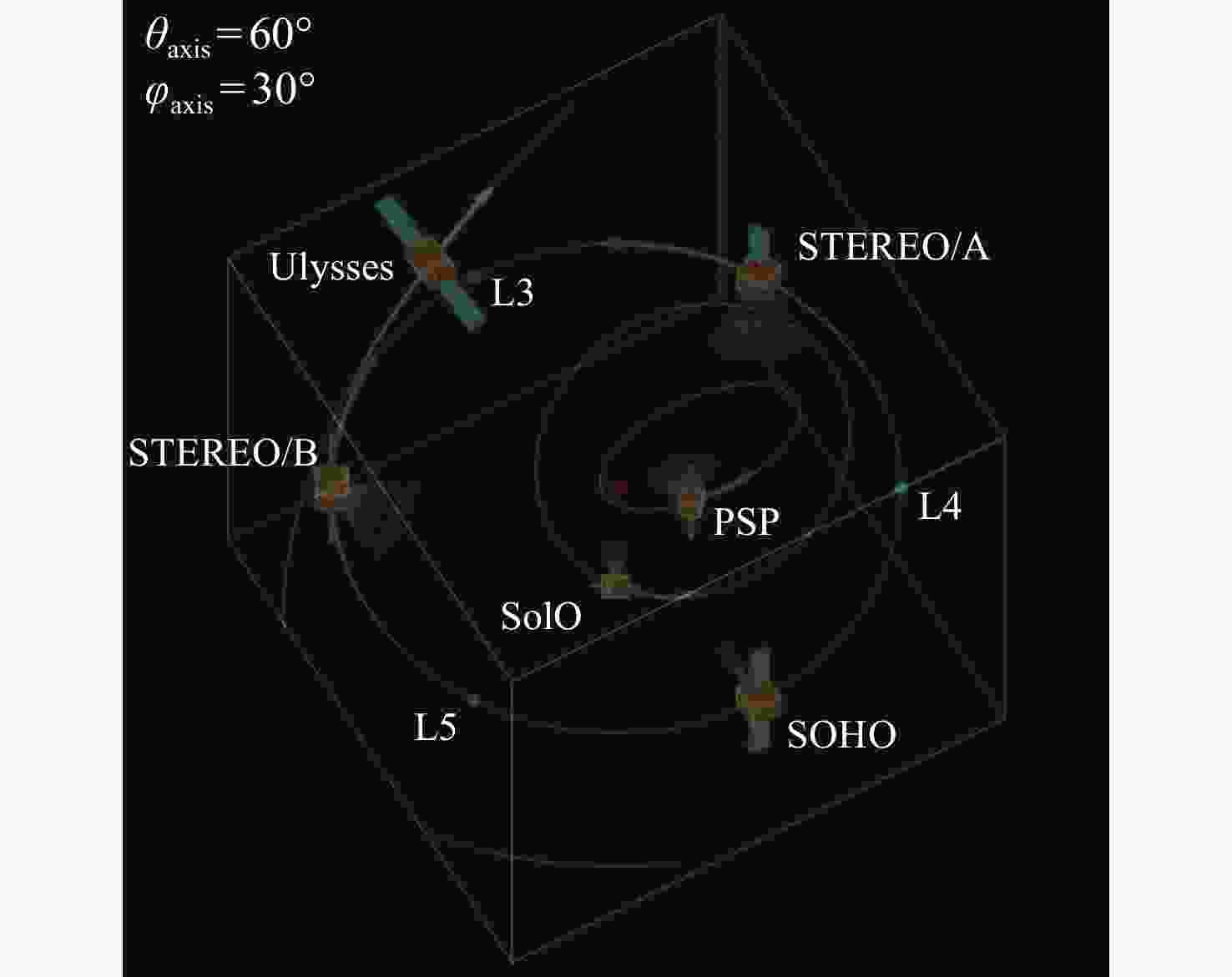
 下载:
下载:
